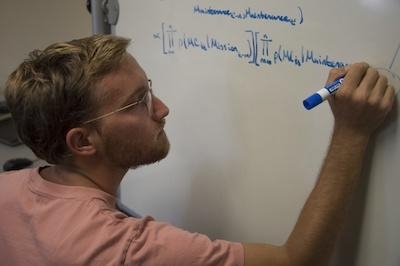Force Readiness Analytics Group (FRAG) Analyzes Data In The Field Of Aviation Readiness
Graduate students from the University of California San Diego (UCSD) joined data scientists from Commander, Naval Air Forces (CNAF) at Naval Air Station North Island for the first-ever collaboration between the National Security Innovation Network’s (NSIN) X-Force Program and CNAF.

CNAF’s Force Readiness Analytics Group (FRAG) analyzes data in the field of aviation readiness, using the information to make informed, data-driven decisions. The FRAG primarily aims to reduce the time an aircraft is non-mission capable by utilizing data to optimize maintenance scheduling and maximize performance.
“We stood up the FRAG in September 2018,” said Senior Chief Machinist’s Mate Aaron Thiss, a member of the CNAP FRAG Team. “Our maintainers were already doing all the maintenance they could, but with so much demand on them it was hard to figure out which aircraft to prioritize. That’s where we came in. We started analyzing data we already had to streamline the maintenance process, which will have major positive effects down the line on readiness, maintainer experience, pilot experience and more.”
NSIN started the X-Force fellowship program this summer and sent three students to the FRAG to help develop a statistical model to predict when an F/A-18E Super Hornet would need preventative maintenance. By analyzing data and utilizing machine learning (the scientific study of algorithms and statistical models), the students and the FRAG team work together to better maintain aircraft by creating a prioritized list of which aircraft need maintenance first, saving time, money and manpower, as well as potentially avoiding in-flight incidents.
“FRAG was tasked with trying to use analytics to fix the low number of mission ready jets, so we are developing a machine-learning model to predict when these jets will break,” said Jordan Coursey, a recent international affairs masters graduate and X-Force fellow at UCSD. “So we can either schedule maintenance to prevent breakage or give [maintenance] control some sort of hierarchy to choose which planes are more or less likely to break.”
The three to six month X-Force fellowship offers 40 students from 10 universities across the country the chance to work hands-on with one of 12 military units. The Navy, Army, Marine Corps and Air Force are all participating in the X-Force program. With their assigned unit, the students used their skills in areas like mobile and web app development, social media strategy and data analysis to solve a real-world problem unique to each individual military unit.
“We have to man, train and equip the fleet, it’s important that we really understand the problems in those areas and then figure out how to provide those solutions,” said Thiss. “So by analyzing this data and becoming more proficient at it, then we can spur other areas and other organizations through the fleet to do the same.”
As the program draws to a close on its first year, the students have been able to reflect on their experiences and what they hope to see their work with X-Force will become going forward.
“I think servicing the U.S. armed forces really benefits the world in a lot of ways, so I’m really excited to be able to do that,” said Aj Langley, a computer sciences master’s student and X-Force fellow at UCSD. “I hope the program keeps going and I hope that as a result of this and the FRAG’s efforts that the military is able to embrace predictive analytics and machine learning even more.”
Coursey said that the difference between operations in the private sector and the military are interesting to experience firsthand, but he hopes to one day be part of bringing the two sectors closer together.
“Personally, I have learned so much from this program, working in such a large organization, working with several different clients — those are all things that have been very beneficial to me.”
The X-Force fellowship gave college students a hands on look at real-world issues and offered the chance to solve them. By partnering with X-Force, CNAF utilized fresh perspectives to adopt solutions to modern military issues.
(Image provided with U.S. Navy news release. Aj Langley, a computer sciences masters student and X-Force fellow, works on his teams data analysis and machine learning project.)
 ANN's Daily Aero-Term (11.14.25): Marker Beacon
ANN's Daily Aero-Term (11.14.25): Marker Beacon Aero-News: Quote of the Day (11.14.25)
Aero-News: Quote of the Day (11.14.25) Classic Aero-TV: CiES All-Digital Fuel Senders
Classic Aero-TV: CiES All-Digital Fuel Senders Airborne 11.10.25: Affordable Expo Succeeds, Citation Ascend, Kenai Shuts Down
Airborne 11.10.25: Affordable Expo Succeeds, Citation Ascend, Kenai Shuts Down NTSB Final Report: Lancair 320
NTSB Final Report: Lancair 320



